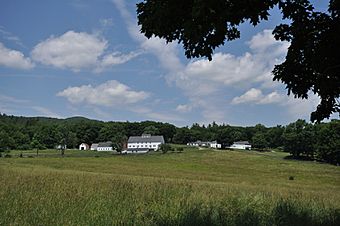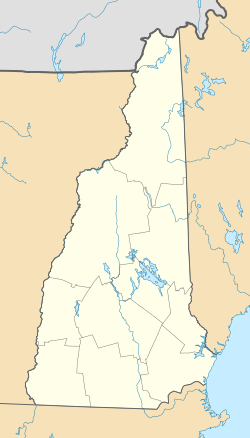True Farm facts for kids
Quick facts for kids |
|
|
True Farm
|
|
 |
|
| Location | 53, 64, 70 True Farm Rd., & 884 NH 113, Holderness, New Hampshire |
|---|---|
| Area | 141 acres (57 ha) |
| Architectural style | Federal; Colonial Revival; Summer camp |
| NRHP reference No. | 12000507 |
| Added to NRHP | August 15, 2012 |
True Farm is a special old farm and summer home in Holderness, New Hampshire. It's located near New Hampshire Route 113 on True Farm Road. The main house was built around 1820. Later, in 1920, a man named George Saltonstall West bought it and turned it into a big summer estate. This large property, about 141 acres, has many buildings and even a small house by a lake. True Farm was added to the National Register of Historic Places in 2012 because of its important history.
Exploring True Farm: A Historic Place
True Farm is about 4 miles northeast of the center of Holderness. It covers more than 140 acres of land. Roads like True Farm Road and New Hampshire Route 113 cross through it. The property has a mix of forests, open fields, and pretty gardens.
What You'll Find at the Farm
You can see different kinds of buildings here. There are homes, farm buildings, and special estate buildings. These include a bathhouse, a playhouse, and a springhouse. The main house was built around 1820. It has a style called Federal. In the 1920s, it got new features in the Colonial Revival style.
A smaller Colonial Revival house was also built in the 1920s. This house was for the farm workers. It sits a short distance southwest of the main house. Some other buildings are hidden in the woods. They are located between Route 113 and Squam Lake.
From Family Farm to Summer Getaway
The True family owned and worked this farm for many years. In 1888, Charles True started renting out part of the farm. This part became Camp Algonquin. It was the second summer camp for children on Squam Lake. The farm also started taking in people who wanted to stay for the summer.
One of the children who went to Camp Algonquin was George Saltonstall West. In 1920, he bought the whole property. He then started to change it into a seasonal summer home. The property still worked as a farm for some time. The West family would send farm products to their main home in Chestnut Hill, Massachusetts. After George West passed away in 1959, the property was divided among his family.



